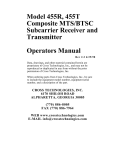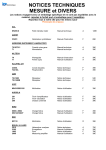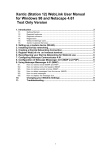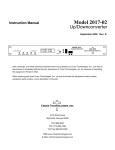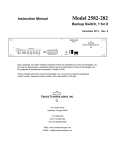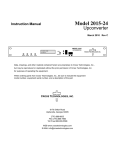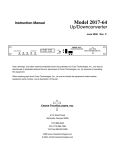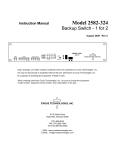Download Cross Technologies 450R Specifications
Transcript
Model 450R, 450T Dual FM Subcarrier Receiver and Transmitter Operators Manual FIRST 8/10/98 REV A 8/26/99 Data, drawings, and other material contained herein are proprietary to Cross Technologies, Inc., and may not be reproduced or duplicated in any form without the prior permission of Cross Technologies, Inc. When ordering parts from Cross Technologies, Inc., be sure to include the equipment model number, equipment serial number, and a description of the part. CROSS TECHNOLOGIES, INC. 6170 SHILOH ROAD ALPHARETTA, GEORGIA 30005 (770) 886-8005 FAX (770) 886-7964 Toll Free 888-900-5588 WEB www.crosstechnologies.com E-MAIL [email protected] 450 Operation Manual Rev A Page 1 8/26/99 Model 450R, 450T Dual FM Subcarrier Receiver and Transmitter Operators Manual TABLE of CONTENTS SECTION TITLE PAGE Warranty........................................................4 OPERATORS SAFETY CONSIDERATIONS................5 1 1-1. 1-2. 1-3. 1-4. GENERAL INFORMATION ................................. 7 INTRODUCTION ........................................................... 7 SPECIFICATIONS .......................................................... 7 SAFETY CONSIDERATIONS ............................................ 7 GENERAL DESCRIPTION ................................................10 2 INSTALLATION ............................................ 11 2-1. INTRODUCTION ........................................................... 11 2-2. INITIAL INSPECTION .................................................... 11 2-3. PREPARATION FOR USE ................................................ 11 2-4. Power Requirements ..................................................... 12 2-5. Line Voltage Selection ................................................... 12 2-6. Power Cable ...............................................................13 2-7. OPERATING ENVIRONMENT .......................................... 13 2-8. RACK MOUNTING ........................................................ 13 2-9. AUDIO, ALARM CONNECTIONS... ................................... 13 2-10. VIDEO BASEBAND CONNECTIONS ................................. 14 2-11. VIDEO FILTERING ....................................................... 14 2-12. REPACKAGING ........................................................... 15 3 OPERATION ................................................ 16 INTRODUCTION .......................................................... 16 APPLYING POWER ....................................................... 17 CONTROL SWITCHES ................................................... 17 STATUS CHANGES ...................................................... 17 ALARM INDICATIONS .................................................. 18 TROUBLESHOOTING .................................................... 19 3-1. 3-2. 3-3. 3-4. 3-5. 3-6. 450 Operation Manual Rev A Page 2 8/26/99 TABLE of CONTENTS SECTION 4 TITLE PAGE ADJUSTMENTS and OPTIONS ........................... 22 4-1. INTRODUCTION ........................................................... 22 4-2. RECOMMENDED TEST EQUIPMENT ................................. 22 4-3. TRANSMITTER FRONT PANEL ADJUSTMENTS .................. 23 4-4. Level Adjustment (IF) ................................................... 23 4-5. Deviation Adjustment (DEV) ........................................... 24 4-6. RECEIVER FRONT PANEL ADJUSTMENTS ........................ 26 4-7. Squelch Adjustment ..................................................... 26 4-8. Audio Adjustment ........................................................ 27 4-9. TRANSMITTER INTERNAL OPTIONS ................................ 27 4-10. Audio Input Level ....................................................... 29 4-11. Audio Input Impedance ................................................. 29 4-12. Emphasis Type (with Compressor OUT) ............................ 29 4-13. RECEIVER INTERNAL OPTIONS ...................................... 30 4-14. Audio Output Level & Impedance .................................... 30 4-15. Emphasis Type (with Expander OUT) ............................... 32 4-16. Input High Pass Filter .................................................. 32 450 Operation Manual Rev A Page 3 8/26/99 WARRANTY This Cross Technologies product is warranted against defects in material and workmanship for one year from the date of shipment. During this period Cross Technologies will either repair or replace, at its option, products which prove to be defective. To obtain service under this warranty, this product must be returned to Cross Technologies at its address. Buyer shall pay all shipping charges to Cross Technologies, and Cross Technologies shall pay all charges for return shipment to buyer. When this product is to be returned from outside the United States, buyer shall pay all shipping charges, taxes, duties or other reasonable or necessary costs to transport the product safely in both directions. LIMITATIONS AND EXCLUSIONS This warranty shall not apply to defects resulting directly or indirectly from any of the following: Improper or inadequate maintenance. User-supplied interfacing or connected equipment. Operation beyond the specifications of the unit or under severe environmental conditions. Improper facility preparation or maintenance. No other warranty is expressed or implied. Cross Technologies specifically disclaims any implied warranties of merchantability or fitness for any particular purpose. Under no circumstances shall Cross Technologies be liable for any incidental, indirect or consequential damages or losses, whether or not Cross Technologies has any advance notice of the possibility of such damages. Correspondence: CROSS TECHNOLOGIES, INC. 6170 Shiloh Road, Alpharetta, GA 30005 Telephone (770) 886-8005 FAX (770) 886-7964 Toll Free (888) 900-5588 E-mail [email protected] 450 Operation Manual Rev A Page 4 8/26/99 OPERATORS SAFETY CONSIDERATIONS General The general safety information in this documentation is for operating and servicing personnel. Specific warnings and cautions will be found throughout the manual where they apply and may or may not appear here. Safety Symbols ___________ _ WARNING _ ___________ WARNING symbols indicate a condition, practice or procedure that, if not properly performed or adhered to, could result in personal injury or loss of life. CAUTION CAUTION symbols indicate a condition, practice or procedure that, if not properly performed or adhered to, could result in damage to the equipment or other property. Before Applying Power CAUTION Verify that the voltage selection on the power receptacle matches the line voltage and the proper fuse is installed. See Section 2. ___________ _ WARNING _ ___________ This equipment is grounded through the grounding conductor of the power cord supplied with the unit. To avoid electrical shock, plug the power cord into a properly wired receptacle. An uninterruptible safety earth ground must be provided from the main power source to the equipment via the power cord. Grounding one conductor of a two conductor wiring system or cord is not sufficient protection. 450 Operation Manual Rev A Page 5 8/26/99 OPERATORS SAFETY CONSIDERATIONS (Cont'd.) ___________ _ WARNING _ ___________ Danger From Loss of Protective Ground Upon loss of the protective ground connection, all accessible conductive parts can render an electrical shock. Do Not Remove Covers or Panels To avoid personal injury or shock, equipment should not be operated without covers or panels. Servicing Servicing instructions are for the use of qualified servicing personnel only. Some adjustments described in this manual are performed with power applied to the equipment and the cover removed. To avoid dangerous shock, only qualified service personnel should perform maintenance. LCD Display Module The LCD Display Module mounted in the front panel is fragile. Care should be taken not to break the exposed glass panel. If broken, extreme caution should be used to avoid cuts from sharp edges. If the liquid crystal material touches your skin or clothes, wash it off immediately using soap and plenty of water. Do not allow any of the liquid crystal material to get in your mouth. 450 Operation Manual Rev A Page 6 8/26/99 Section 1 - GENERAL INFORMATION 1-1. INTRODUCTION. This manual contains information necessary for the installation, operation, testing and alignment of the Model 450 FM Subcarrier. The documentation for this product is divided into five sections as described below. Section 1. General_Information: provides general information about this equipment, circuit description and specifications. Section 2. Installation: provides installation information including initial inspection, installation and repackaging the equipment. Section 3. Operation: provides information about front panel checks and settings. Section 4. Performance_Tests: provides information to verify the performance of the equipment. Section 5. Adjustment & Options: provides information to adjust the equipment, and to select the various options. 1-2. SPECIFICATIONS. The specifications are listed in Table 1-1. These are performance standards to which the Model 450 is aligned and tested. 1-3. SAFETY CONSIDERATIONS. Safety information, relating to installation, testing, etc. is found throughout this manual. Please refer to OPERATORS SAFETY CONSIDERATIONS at the beginning of this manual. CROSS TECHNOLOGIES INC. DEV IF DEV IF CROSS TECHNOLOGIES INC. SQUELCH AUDIO SQUELCH AUDIO 5.41MHz 6.17MHz 6.20MHz 6.80MHz 450 SUBCARRIER TRANSMITTER PROGRAM ALARM A B EXECUTE 450 SUBCARRIER RECEIVER PROGRAM ALARM A B EXECUTE Figure 1.1 450 Subcarrier Transmitter and Receiver 450 Operation Manual Rev A Page 7 8/26/99 TABLE 1-1 SPECIFICATIONS Audio Interface: Input/Output Frequency range ..................... 40 Hz to 15 kHz Peak program level ................. +9 or+18 dBm selectable Impedance ............................ 600Ω or high Z in 600Ω or low Z out Balanced, transformer coupled Connector type ...................... Terminal block Audio Characteristics: (with 3:1 compandor and emphasis) Dynamic range ....................... >90 dB Frequency response ................ ±0.25 dB Total harmonic distortion (1 kHz @ PPL) ...................... <0.1% Intermodulation distortion .......... <1% Interchannel phase difference 1000 Hz ........................ <6° 50 Hz and 15 kHz ............ <10° Compandor type .................... 3:1 improved Modulator Characteristics: Output frequency range ............ Frequency agile from 1.0 to 9.99 MHz in 10kHz steps. Frequency stability ................. ±300 Hz over operating temperature range. Connector type ...................... BNC Female Peak carrier deviation(PPL) ....... ±75 kHz (adj.) Subcarrier level ...................... 25 to 100 mV P/P (adj.) Output impedance ................... bridging (>4 k ohms) Demodulator Characteristics: Input frequency range .............. Frequency agile from 1.0 to 9.99 MHz in 10 kHz steps. Operating channel spacing ......... 280 kHz, minimum Connector type ...................... BNC Female Impedance ........................... bridging (>4 k ohms) Input level ............................ 25 to 100 mV Recommended operating conditions for satellite applications ...... C/n≥61 db•Hz 450 Operation Manual Rev A Page 8 8/26/99 TABLE 1-1 SPECIFICATIONS (Cont'd.) Power Requirements: Standard...............................115/230 VAC (47-63 Hz) Environmental Requirements: Ambient temperature for: Storage .......................... -20°C to +70°C Specification .................... +10°C to +40°C Humidity. ............................ 95% maximum Altitude: Storage .......................... 12,200 meters(40,260 ft.) ASL Specifications .................... 3,050 meters(10,000 ft.) ASL Alarms: Front panel visual and Form C contact. Receiver ............................. Operates upon degradation of either carrier or frequency. Transmitter .......................... Operates upon degradation of either carrier frequency or loss of synthesizer lock. Dimensions: 2 channel transmitter ................ 44.4 mm (1.75") H X 483 mm (19")W X 381 mm (15")D 2 channel receiver ................... same as above 450 Operation Manual Rev A Page 9 8/26/99 1-4.GENERAL DESCRIPTION. The Model 450 Dual FM Subcarrier System consists of two complete frequency agile FM transmitters or receivers in a single enclosure. A common microprocessor circuit is used to program the operating frequencies of the channels, monitor alarm conditions, and configure some system options. The microprocessor circuit incorporates a non-volatile memory device that retains the most recent settings indefinitely during power outages or prolonged storage. The 450 was designed to provide the wide dynamic range, low distortion transmission path required for today's digitally mastered and recorded program material, while maintaining the traditional bandwidth and poor-path performance advantages of analog FM techniques. Essential to accomplishing this is a newly designed precision audio noise reduction system. This system consists of a dynamic range compressor in the transmitter, and a complementary dynamic range expander in the receiver. The compressor/expander ("compandor") system incorporates fast attack RMS detection, multipole pre- and de-emphasis, overshoot limiting, and audio bandwidth filtering. For applications requiring compatibility with existing uncompanded subcarrier equipment, the compressor and expander can be switched out of the signal path by the microprocessor. Internal jumper options then select either 75 uS or CCITT J.17 emphasis networks (75uS factory setting). The video baseband is combined with the subcarrier signals in the transmitter by a low component count passive directional coupler. This circuit has been designed to put virtually no load on the video line (>4 K ohm), allowing multiple units to be "daisy-chained" without adversely affecting the signals on the baseband. The low component count and passive nature of this circuit provide excellent protection against disruption of the baseband due to component failure or loss of power in the 450. While the 450 Subcarrier system is most often used in conjunction with video signals, the wide operating frequency range and narrow bandwidth also make the unit attractive for multi-channel applications on a video baseband without video. To accommodate these applications, the 450 Receiver incorporates an internal jumper option to bypass the input highpass filter that normally protects the discriminator circuits from the high level video signal. With the highpass filter strapped out, the entire baseband is available to the receiver. 450 Operation Manual Rev A Page 10 8/26/99 Section 2 INSTALLATION 2-1. INTRODUCTION. - This section contains instructions for installing and interfacing the Model 450 Dual FM Subcarrier. Included are initial inspection procedures, power and grounding requirements, line voltage selection, interface connections and instructions for repackaging the equipment. 2-2. INITIAL INSPECTION. ___________ _ WARNING _ ___________ In the event that any portion of the outer enclosure of the unit has been damaged, a hazardous electrical shock condition may exist. In this case, do not apply power to the unit, or attempt to perform electrical tests. Inspect the shipping container for damage. The shipping container and cushioning material should be kept until the contents of the shipment have been checked for completeness and the equipment has been checked mechanically and electrically. This equipment was carefully inspected both mechanically and electrically before shipment. It should be free of mars and scratches and in perfect electrical order upon receipt. If there is mechanical damage or defect due to shipment, notify the carrier immediately. Keep the shipping material for the carrier's inspection. In the event of mechanical damage, or if the equipment does not pass electrical performance tests, notify the Cross Technologies, Inc. office immediately. The warranty statement is located in the front of this manual. 2-3. PREPARATION FOR USE. - Each unit is shipped from the factory with the following strapping options: Factory Setting Optional Setting Audio level (PPL) ...................... +18 dBm .............. +9 dBm Audio impedance (Transmit) ............. 600 Ω ................ low Z Audio impedance (Receive) .............. 600 Ω ............... high Z Emphasis (with Compandor OFF) ....... 75 µs .............. CCITT J.17 Highpass filter (Receive) ............. IN (Video present) ... OUT (no Video) Power ................................... 105-130 Vac .......... 210-250 Vac To change the line voltage setting of your unit, please refer to Paragraph 2-5. To change the other settings, please refer to Section 5. 450 Operation Manual Rev A Page 11 8/26/99 2-4. POWER REQUIREMENTS. - The Model 450 requires a power source of 105V-130V 50-60Hz or 210V-250V 50-60Hz. Power consumption is: Transmitter.................. 28 VA maximum. Receiver..................... 24 VA maximum. 2-5. LINE VOLTAGE SELECTION. CAUTION Before connecting ac power to this equipment, make sure it is set to the line voltage of the power source. Also ensure that the common connection of the power outlet is connected to a protective earth contact. ___________ _ WARNING _ ___________ Line voltage selection is made at the ac plug-in receptacle on the rear of the shelf (see Figure 2.1). This should be done by trained service personnel only. To avoid electrical shock, make sure the power cord is disconnected before changing the voltage selection pc board. Before connecting this device to the power source, verify that a protective earth ground connection is provided through the grounding conductor of the power cord. The protective ground connection through the power cord grounding conductor is essential for safe operation. The Model 450 is shipped from the factory with the line voltage selection set for 105-130 Vac. If it is necessary to change the line voltage selection, access to the voltage selection pc board can be accomplished by (see Figure 2.1): 1.) Removing the ac cord. 2.) Open the cover door, rotate the fuse-pull to the left, removing the fuse. 3.) Remove the pc board. Select operating voltage by orienting the pc board to position desired voltage on top-left side. Push board firmly into module slot. 4.) Rotate fuse-pull back into normal position and re-insert fuse into holder, using caution to select the proper fuse value. 450 Operation Manual Rev A Page 12 8/26/99 Figure 2.1 AC Connector 2-6. POWER CABLE. - In accordance with safety standards, this equipment is supplied with a three conductor cable. When connected to an appropriate power line outlet, this cable grounds the instrument cabinet. 2-7. OPERATING ENVIRONMENT. - The operating environment should be within the following limitations: Temperature........................ +10 °C to +40 °C Humidity........................... 95% maximum Altitude........................... 3050 meters(10,000 ft.) ASL 2-8. RACK MOUNTING. - The Model 450 is intended for rack mounting in a rack having an EIA standard width of 482.6 mm (19 inches). It is shipped from the factory with the mounting brackets set for flush mounting. Optionally the mounting brackets can be reversed for extended mounting (5 inches). Four 12-24 screws are required for mounting in the rack. 2-9. AUDIO, ALARM CONNECTIONS. - Audio and alarm connections are made at the 9 position terminal block on the rear of the equipment. A thin-bladed flat screwdriver is required. Connections are made as marked on the rear panel. Terminals will accept wire sizes up to 12 AWG maximum. 450 Operation Manual Rev A Page 13 8/26/99 2-10. VIDEO/BASEBAND CONNECTIONS. - Baseband connections are BNC connectors on the rear of the shelf. A detailed description of the connections are: Transmitter: Input ... Video input from video source. If video is not used this port is terminated with 75 ohms. In multiple-unit operation, the input of units after the first is connected to the output of the preceding unit. Output ..Composite output to microwave or satellite transmitter. In multiple unit operation, the output of all but the last unit connects to the input of subsequent units. Receiver: Input ... Composite input from microwave or satellite receiver. In multiple-unit operation, the input of units after the first is connected to the output of the preceding unit. Output .. Video output to monitor or video receiving equipment. If video is not used, this port is terminated with 75 ohms. In multiple unit operation, the output of all but the last unit connects to the input of subsequent units. 2-11. VIDEO FILTERING. - The video source should be adequately filtered to prevent harmonics or other high frequency components from interfering with the low level subcarrier signals in the upper part of the baseband. If the video signal source does not include a suitable lowpass filter, a video lowpass filter should be added to the system between the video source and the first subcarrier transmitter. At the receive site, video quality is improved by using a filter to remove the high frequency subcarrier signals prior to the video equipment. If an adequate video lowpass filter is not included in the video receiving equipment, one should be added between the last subcarrier receiver and the video equipment. CAUTIOFOR CONTINUOUS FIRE PROTECTION N: REPLACE ONLY WITH SPECIFIED TYPE RANGE AND LINE VOLTAGE FUSE 250V RATED FUSE 105V-130V 50-60Hz 2 A 210V-250V 50-60Hz 1 A INPUT OUTPUT CAUTION: NO OPERATOR SERVICEABLE PARTS INSIDE. REFER SERVICING TO QUALIFIED PERSONNEL. N O C O N M C ALM T R A T R B Figure 2.2 450 Subcarrier Transmitter and Receiver Rear Panel 450 Operation Manual Rev A Page 14 8/26/99 2-12. REPACKAGING. - If the equipment is to be returned to Cross Technologies, Inc. for any reason, care should be taken in packaging. Call Cross Technologies, Inc. for a Return Material Authorization (RMA) number. Enclose documents detailing reason for return, return address, name and telephone number of contact person. Original Packaging. It is preferable to use the original packaging if it was retained. Use care in packing, sealing and marking the container. Other Packaging. The general instructions below should be followed if re-packaging is done with commercially available material. 1. A strong container should be used. Minimum requirement would be of singlewall construction, 200 pound test material. 2. The equipment should be wrapped in plastic with 3 to 4 inches of shock absorbing material on all sides. Anti-static material is preferred but not mandatory. 3. Seal the container securely. Be sure the container is properly marked. If the unit is being returned for repair: Please refer to Section 3-6, Troubleshooting, before returning the unit to the factory for repair. If the problem cannot be remedied locally, please include as much information as possible about the nature of the problem you are experiencing, as well as information about your system configuration, including frequencies and levels of the various signals on the baseband. 450 Operation Manual Rev A Page 15 8/26/99 Section 3 OPERATION 3-1. INTRODUCTION. - This section describes operation of the front panel controls. There are three operator switches, the LCD display and an alarm indicator. All functions for both A and B channels are controlled by these components. The functions are: 1. Turn either channel "on" or "off". 2. Set frequency of either channel. 3. Activate or deactivate the compressor/expander. Alarm indications appear on the LCD display but are not controlled by the operator. Both hardware and software have been designed to make reprogramming as "tamper proof" as possible. The Program/Execute switch is recessed so it will not inadvertently be operated. All program changes must start with the operation of the Program/Execute switch and must end with the operation of the Program/Execute switch. If this sequence is not followed, none of the changes will take effect. If programming is initiated and no operator action takes place for approximately 12 seconds (before the final press of the Program/Execute switch) the display will revert to its previous status and you will need to start over. 3-2. APPLYING POWER. NOTE: The last status of a unit is retained even when power is removed. The next time power is applied, the unit will return to it's previous settings. When power is first applied, the LCD display goes through four steps. 1. The LCD goes black to show all segments are functioning. 2. The display will show the unit model number. __________________ __________________ _450 Transmitter _ or _450 Receiver _ __________________ __________________ 3. The software version will be displayed. __________________ _Software Rev #.#_ __________________ 4. The present status of both channels is shown. Note: Information for the "A" channel is given in the left-hand half of the display window, and for the "B" channel in the right-hand half. The unit is now operational and ready for any changes the operator may desire. 450 Operation Manual Rev A Page 16 8/26/99 3-3. CONTROL SWITCHES. 1. Program/Execute. Any change to the programming of the unit must be initiated by pressing the Program/Execute switch and completed by pressing the Program/Execute switch. 2. Cursor Movement - Horizontal. This switch is mounted so its movement is horizontal and moves the cursor left or right. It is also used to select the "A"(left) or "B"(right) channel at the beginning of programming. 3. Vertical Switch. This switch is mounted so its movement is vertical and has two functions: A) During frequency changes, the vertical movement will raise or lower the frequency in the direction of the arrows. B) For other functions such as on/off or compandor disable, the vertical switch will alternately turn the function on or off regardless of the direction operated. 3-4. STATUS CHANGES. - To modify the status of a channel: 1. Operate the Program/Execute switch. The display will read: __________________ _MODIFY A OR B ? _ __________________ 2. Select channel A or B by operating the horizontal switch in either the A or B direction. 3. Status of the selected channel will be displayed. For example: __________________ _A 6.60MHz ON _ __________________ 4. By using the horizontal rocker switch the cursor can be moved left or right to either the ON/OFF position or to any digit of the frequency. A. If ON/OFF is selected, the status can be modified by operating the vertical switch. This will alternately turn the channel on or off. B. If changes are desired in the frequency, move the cursor to the digit that you wish to modify. By using the vertical switch, that digit can be raised or lowered by the direction of the arrow. The cursor can then be moved to another digit and the action repeated until the desired frequency is displayed. 450 Operation Manual Rev A Page 17 8/26/99 NOTE: The modified frequency and ON/OFF condition will not become effective until the final operation of the Program/Execute switch described in the next paragraph. To prevent interruption of other channels when a frequency change takes place, the 450 automatically mutes the carrier until the phase locked loop frequency synthesizer has stabilized at the new frequency. 5. Operate the Program/Execute switch. The display will now show the Compressor or Expander status (IN/OUT). If you wish to make a change, operate the vertical switch to toggle the status. When the display indicates the desired condition, press the Program/Execute switch a final time. At this time the changes you have made will become the new settings for the channel. 3-5. ALARM INDICATIONS. - An alarm condition for either channel will: 1. Illuminate the alarm indicator, 2. Indicate the alarm status on the LCD display, 3. Cause a form C relay closure to appear at the terminal block on the rear of the shelf for remote indication. 4. Mute the output of the channel (audio in the case of a receiver, or the subcarrier in a transmitter). The left side of the LCD indicates alarms for channel A and the right side for channel B. Alarms are: Transmitter : CXR ALM if the carrier frequency deviates beyond predetermined limits. AFC ALM if the synthesizer is out of lock. CXR AFC if both alarms are present. Receiver: CXR ALM upon a drop in incoming carrier level beyond the squelch setting or the RF/IF section of the receiver is defective. AFC ALM if the incoming carrier is off frequency or if the frequency determining elements of the receiver are defective. CXR AFC if both alarms are present. CAUTION An annoying remote alarm can be disabled by turning the channel "off". If this is done there will be no alarm condition active to remind maintenance personnel there is a problem. The channel may be brought on-line by someone unaware of the existing problem. 450 Operation Manual Rev A Page 18 8/26/99 3-6. TROUBLESHOOTING. In the event of difficulty with the 450 Subcarrier System, the following list of possible causes should be reviewed prior to contacting the factory for repair. In the event that factory repair is deemed necessary, please refer to Section 2-12., Repackaging, for information on returning the unit. PROBLEM/SYMPTOM POSSIBLE CAUSE Audio sound quality not acceptable. Symptoms could include one or more of the following: If Compressor/Expander are being used, both ends must be set IN. If not being used both ends must be set OUT. (See Section 3-4) High distortion Poor frequency resp. Sounds too loud (compressed) Sounds too quiet (expanded) Sounds noisy If Compressor/Expander are not being used, check internal emphasis selection. (See Section 4-12 & 4-16) Both ends must be set the same. Audio is noisy, but sounds normal in other respects. Transmission path noise may require use of companding for acceptable noise performance. Set Compressor and Expander IN and re-evaluate. (see Section 3-4) If Compressor and Expander are both IN, system may be operating below threshold. Check other system components and antenna pointing. In non-video systems, if the subcarrier frequency is less than about 4.5MHz, the high pass filter in the receiver may not be set OUT. (See Section 4-17.) 450 Operation Manual Rev A Page 19 8/26/99 PROBLEM/SYMPTOM Audio sounds noisy. Tones, chirps, buzz, etc may also be present. POSSIBLE CAUSE Channel spacing may be too close. The 450 requires 280 kHz between adjacent channel center frequencies to meet all specifications. At closer spacings some of these symptoms may appear. The subcarrier channel may be co-located with one of the harmonics of a video signal component (e.g., colorburst). Shift subcarrier frequencies and reevaluate. Total baseband power may be too high, leading to intermodulation products. Reduce the level of the subcarriers and/or video and reevaluate. In systems with video, the high pass filter in the receiver may be set OUT. (See Section 4-17.) Audio level and/or carrier deviation too high or low. LCD display blank. 450 Operation Manual Rev A Verify correct audio impedance for system. (See Section 4-11 or 4-15.) Loss of power. Possible causes include blown fuse, incorrect line voltage selection, etc. (See Section 2-5.) Page 20 8/26/99 PROBLEM/SYMPTOM LCD display shows: NV Memory Error Receiver LCD display indicates a CXR alarm. POSSIBLE CAUSE A checksum error was found after reading the nonvolatile memory device. The unit may still be used (press the Program/Execute switch to proceed) but should be returned for repair as soon as convenient since a power interruption may cause loss of the unit's programmed settings. Receiver may be set to an incorrect frequency, or the transmit site may not be operating on the specified frequency. Receiver SQUELCH adjustment may need to be changed. (See Section 4-7) The subcarrier transmitter for the specified frequency may not be operating, or may be at a reduced carrier level. Receiver LCD display indicates an AFC alarm. Any of the situations described above for a CXR alarm may, under some conditions, also cause an AFC alarm. The receiver may be tuned to a wide deviation channel which it is unable to track. 450 Operation Manual Rev A Page 21 8/26/99 Section 4 - ADJUSTMENTS and OPTIONS 4-1. INTRODUCTION. - This section describes operator adjustments and the selection of the internal options. For a discussion of the microprocessor-controlled functions (Channel ON/OFF, FREQUENCY and compandor IN/OUT) please refer to Section 3-4. For a discussion of line voltage selection, please refer to Section 2-5. Throughout this section, the terms PPL and APL are used in referring to audio levels. For a thorough discussion of these terms and equivalent CCITT test levels, please refer to Appendix A. The operator adjustments are located on the front panel on both the transmitter and receiver. The transmitter adjustments consist of subcarrier level and deviation trims. The receiver adjustments consist of squelch threshold and audio output level trims. The internal options include selection of audio levels and impedances, emphasis type (with companding OUT), and the receive highpass filter. These options are configured at the factory prior to shipment as follows: Audio Input/Output Levels .............. +18 dBm Audio Impedance ......................... 600 Ω Emphasis Type ............................75 µS Receive Highpass Filter .................... IN These settings will be suitable for the majority of applications, and should only rarely need to be changed. 4-2. RECOMMENDED TEST EQUIPMENT. Note: The equipment listed below comprises all of the test equipment mentioned in this section. It is not necessary to have all of these items on hand to perform the adjustments. Refer to each subsection for the specific items needed. Item Manufacturer & Model Audio Analyzer ................... HP 8903B Modulation Monitor .............. Marconi TF2300A AC Voltmeter ...................... Fluke 8920A Spectrum Analyzer ................HP 8552B/8553B Frequency Selective VM ........ HP 3586C Oscilloscope .........................Tektronix 2235 75 Ohm 1% BNC Termination .. Any Equivalent equipment is acceptable. The specifications of the alternate instrument should be significantly better than the accuracy of the measurement made. 450 Operation Manual Rev A Page 22 8/26/99 4-3. TRANSMITTER FRONT PANEL ADJUSTMENTS. NOTE:Prior to setting levels be sure transmitter is ON and set to proper frequency. See Section 3. 4-4. Level Adjustment (IF). - Determine the desired subcarrier level for your specific system. The 450 Transmitter subcarrier level can be adjusted over the range of 25 mV to 100 mV p/p (approx. -18 TO -30 dB, 75 ohm). A. Level Adjustment Without Video or Other Channels. - If it is possible to set the subcarrier level with all other signals (i.e., video and all other subcarriers) removed from the baseband, the desired subcarrier level may be set directly using an oscilloscope or wideband AC voltmeter. Please note that it is necessary to set the second channel within the 450 Transmitter to the OFF status in order to use this method. If it is necessary to adjust the subcarrier level in a "live" circuit with video and/or other subcarriers present, proceed to the method described in Paragraph B., below; otherwise, proceed as follows: 1. Connect the INPUT BNC connector of the 450 Transmitter to a suitable 75 Ohm termination. 2. Connect the OUTPUT BNC connector of the 450 Transmitter to the measuring instrument (either an oscilloscope or wideband AC voltmeter). If the measuring instrument has a high impedance input (normally the case), this line should also be terminated with a suitable 75 ohm termination. 3. Make certain that the second channel of the 450 Transmitter (whichever channel is not now being adjusted) is set to the OFF Status. 4. Adjust the IF (subcarrier level) screwdriver adjustment on the front panel for the proper system level. 5. The other channel may now be adjusted by reversing the ON/OFF status of the two channels. B. Level Adjustment With Video and/or Other Channels. - When other signals (such as video or other subcarrier channels) are present on the baseband, it is necessary to use a measuring instrument that can be tuned to the desired signal (such as a spectrum analyzer, frequency selective level meter, or modulation meter with level measuring capability). Proceed as follows: 1. If the measuring instrument has a high impedance input, connect it to the baseband signal at any convenient point after the insertion of the subcarrier to be adjusted. If the measuring instrument has a low impedance (i.e., 75 or 50 ohm) it is necessary to connect the instrument to an isolated monitor point in order to prevent the additional load presented by the low impedance input from affecting the level to be measured. 450 Operation Manual Rev A Page 23 8/26/99 2. With the measuring instrument properly tuned to the frequency of the channel to be adjusted, set the IF (subcarrier level) screwdriver adjustment on the front panel for the proper level for your system. 3. Adjust the second channel of the 450 Transmitter after re-tuning the measuring instrument to the appropriate frequency. 4-5.Deviation Adjustment (DEV). - The 450 Transmitter is designed to operate with a peak deviation of the subcarrier of 75 kHz (150 kHz peak-to-peak) for an audio input corresponding to Peak Program Level (PPL). The front panel DEV adjustment is provided to compensate for minor variations in incoming audio signal strength, and is not intended to provide for operation at deviations other than the 450's specified deviation. The deviation may be accurately set using either a modulation meter or a spectrum analyzer; choose the method you find most suitable. A. Deviation Adjustment Using a Modulation Meter. 1. If the modulation meter has a high impedance input, connect it to the baseband signal at any convenient point after the insertion of the subcarrier to be adjusted. If the measuring instrument has a low impedance (i.e., 75 or 50 ohm) it is necessary to connect the instrument to an isolated monitor point in order to prevent the additional load presented by the low impedance input from affecting the levels of the signals on the baseband (this level change has no direct effect on the adjustment of subcarrier deviation, and may be ignored if there are no active receive sites that may be adversely affected). 2.Connect an audio signal generator to the T, R, and ground connections of the channel to be adjusted. The audio signal generator should be set to provide a 1 kHz test signal at Peak Program Level. 3.With the modulation meter properly tuned to the frequency of the channel to be adjusted, adjust the front panel screwdriver adjustment DEV until the modulation meter indicates 75kHz peak deviation (150kHz peak-to-peak). 4.Adjust the second channel of the 450 Transmitter after re-tuning the modulation meter to the appropriate frequency, and transferring the audio signal generator to the T, R, and ground connections of the second channel. 450 Operation Manual Rev A Page 24 8/26/99 B. Deviation Adjustment Using a Spectrum Analyzer. 1. If the spectrum analyzer has a high impedance input, connect it to the baseband signal at any convenient point after the insertion of the subcarrier to be adjusted. If the measuring instrument has a low impedance (i.e., 75 or 50 ohm) it is necessary to connect the instrument to an isolated monitor point in order to prevent the additional load presented by the low impedance input from affecting the levels of the signals on the baseband (this level change has no direct effect on the adjustment of subcarrier deviation, and may be ignored if there are no active receive sites that may be adversely affected). 2. Connect an audio signal generator to the T, R, and ground connections of the channel to be adjusted. The audio signal generator should be set to provide a 13.587 kHz test signal at the following amplitude: Setup Amplitude for test signal Compressor IN Peak Program Level (PPL) Compressor OUT (75µS Emphasis) 15.36 dB below PPL Compressor OUT 11.31 dB below PPL (CCITT J.17 Emphasis) 3. Temporarily disconnect the audio signal generator. Tune the spectrum analyzer to the frequency of the subcarrier to be adjusted. The spectrum analyzer should be set for a scan width of not greater than 20 kHz per horizontal division, and not less than 5 kHz per horizontal division, and the bandwidth should be no greater than 3 kHz. Verify that the desired carrier is clearly visible at the exact center of the analyzer screen. Adjust the gain/attenuation settings of the analyzer so that the peak of the carrier is near the top of the screen, and the vertical resolution is 10 dB per division. Reconnect the audio signal generator. Sidebands of the carrier frequency should be visible at 13.587 kHz intervals on the screen. The center (carrier) signal may or may not be visible, depending on the existing adjustment of the front panel DEV control. Adjust the front panel screwdriver adjustment DEV for a minimum level (null) at the center (carrier) frequency. You have now adjusted the deviation for exactly 75kHz peak (150kHz peak-to-peak). 4. If the second channel of the 450 Transmitter is also to be adjusted, repeat steps 2. and 3., above. 450 Operation Manual Rev A Page 25 8/26/99 4-6. RECEIVER FRONT PANEL ADJUSTMENTS. NOTE: Prior to setting levels be sure receiver is ON and set to proper frequency. See Section 3. 4-7. Squelch Adjustment. A. Tune the receiver to an active channel. Presence of an Alarm indication and a CXR ALM display may indicate one or more of the following conditions: 1) No carrier is being received. 2) Squelch adjusted improperly. 3) The carrier receiver is malfunctioning. Whenever there is a CXR ALM (regardless of cause) there should be no audio output from the receive channel with the alarm. B. Squelch is factory set to operate if the incoming subcarrier amplitude drops below 25 mV p/p. If you wish to adjust the squelch threshold for your unique receive site conditions, or if you are using subcarrier levels of less than 50 mV p/p, proceed as follows: 1. If the CXR ALM is displayed, adjust SQUELCH counterclockwise until the Alarm extinguishes. 2. With the Alarm off, adjust the SQUELCH clockwise until the Alarm just lights. This is the receiver squelch threshold. 3. Tune the receiver to an unused channel (i.e. no RF carrier). 4. IMPORTANT - COUNT TURNS THIS STEP: Turn the SQUELCH counterclockwise until the CXR ALM just extinguishes due to RF noise. 5. Turn the SQUELCH control clockwise one-half the number of turns counted in Step 4. 6. Return to an operating channel. The receiver is now adjusted to squelch at a level halfway between the operating carrier and the RF noise floor. 450 Operation Manual Rev A Page 26 8/26/99 4-8. Audio Adjustment. A. Connect a high impedance AC Voltmeter across the T and R terminals for the appropriate channel at the rear of the unit under test. The audio equipment that will normally be connected to these points should remain connected while performing this measurement. B. Have a 450 transmitter site send a continuous tone of 1 kHz at Peak Program Level. C. Use the AUDIO screwdriver control on the front panel to adjust the receiver output to Peak Program Level. D. Do this for both channels. 4-9. TRANSMITTER INTERNAL OPTIONS. The internal options are selected with jumper plugs on the internal printed circuit board, and require removal of the top cover plate of the units. ___________ _ WARNING _ ___________ Unplug the power cord from the equipment before removing any cover plates. Failure to do so could result in a hazardous electrical shock, and/or damage to the equipment. Replace all cover plates prior to restoring power to the equipment. The top cover plate is held in place by 11 flat head phillips machine screws, 2 of which pass through the top edge of the front panel. After removing these screws, carefully remove the top cover plate by tilting the rear edge up slightly and sliding it out from under the top edge of the front panel. Refer to Figure 4-1 for the locations of the jumper blocks described in the following sections. 450 Operation Manual Rev A Page 27 8/26/99 J2 OUT TB1 AUDIO - ALM J2 J1 IN J1 TB1 P9 P8 T2 T3 T4 T1 P4 P3 P2 P5 S3 P4 IMPED P3 PPL P2 IMPED S2 S1 DS1 P8 P9 EMPH EMPH P5 PPL Figure 4-1 Transmitter Jumper Block Locations. 450 Operation Manual Rev A Page 28 8/26/99 4-10. Transmitter Audio Input Level. - The audio input level selection is made on jumper block P3 for the "A" channel, and on P5 for the "B" channel. The jumper positions (looking from the front of the unit) are: P3 or P5 +18 dBm PPL P3 or P5 +9 dBm PPL 4-11. Transmitter Audio Input Impedance. - The audio input impedance selection is made with jumper block P2 for the "A" channel, and P4 for the "B" channel. The jumper positions (looking from the front of the unit) are: P2 or P4 High Impedance P2 or P4 600 Ohm 4-12. Transmitter Emphasis Type. - The emphasis type selection controls the pre-emphasis used only when the compressor is switched OUT. The compressor includes its own emphasis system that cannot be modified. Emphasis selection for the "A" channel is made with jumper block P8, and for the "B" channel with P9. The jumper positions (looking from the front of the unit) are: P8 or P9 P8 or P9 75 uS J.17 75 uS J.17 75µS 450 Operation Manual Rev A 75 uS J.17 75 uS J.17 CCITT J.17 Page 29 8/26/99 4-13. RECEIVER INTERNAL OPTIONS. - The internal options are selected with jumper plugs on the internal printed circuit board, and require removal of the top cover plate of the units. ___________ _ WARNING _ ___________ Unplug the power cord from the equipment before removing any cover plates. Failure to do so could result in a hazardous electrical shock, and/or damage to the equipment. Replace all cover plates prior to restoring power to the equipment. The top cover plate is held in place by 11 flat head phillips machine screws, 2 of which pass through the top edge of the front panel. After removing these screws, carefully remove the top cover plate by tilting the rear edge up slightly and sliding it out from under the top edge of the front panel. Refer to Figure 4-2 for the locations of the jumper blocks described in the following sections. 4-14. Receiver Audio Output Level and Impedance. - The audio output level and impedance selections are made on jumper block P2 for the "A" channel, and on P3 for the "B" channel. The jumper positions (looking from the front of the unit) are: P2 or P3 P2 or P3 +18 +9 +18 +9 +18 dBm PPL 600 P2 or P3 +18 +9 +18 +9 +18 dBm PPL Low Impedance 450 Operation Manual Rev A P2 or P3 +18 +9 +18 +9 +9 dBm PPL 600 Page 30 +18 +9 +18 +9 +9 dBm PPL Low Impedance 8/26/99 J2 OUT TB1 AUDIO - ALM J2 J1 IN J1 P8 TB1 P5 P4 T3 T2 T4 T1 P4 P2 P3 S3 S2 S1 DS1 P2 P3 P4 P5 P8 PPL PPL EMPH EMPH VID HPF Figure 4-1 Receiver Jumper Block Locations. 450 Operation Manual Rev A Page 31 8/26/99 4-15. Receiver Emphasis Type. - The emphasis type selection controls the de-emphasis used only when the expander is switched out. The expander includes its own emphasis system that cannot be modified. Emphasis selection for the "A" channel is made with jumper block P4, and for the "B" channel with P5. The jumper positions (looking from the front of the unit) are: P4 or P5 P4 or P5 75 uS J.17 75 uS J.17 75µS 75 uS J.17 75 uS J.17 CCITT J.17 4-16. Input Highpass Filter. - The 450 Receiver input circuitry includes a highpass filter that is designed to prevent high level video signals at the bottom of the baseband from overloading sensitive sections of the receiver. In applications where video is present on the baseband, this filter should always be strapped IN. In applications without video, where the entire baseband is dedicated to subcarriers, the filter should be jumpered in the OUT position. The input highpass filter selection is common to both channels, and is made with P8. The jumper positions (looking from the front of the unit) are: P8 HPF P8 HPF OUT IN OUT IN OUT IN OUT IN Highpass Filter IN 450 Operation Manual Rev A Highpass Filter OUT Page 32 8/26/99
































